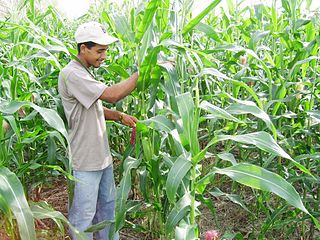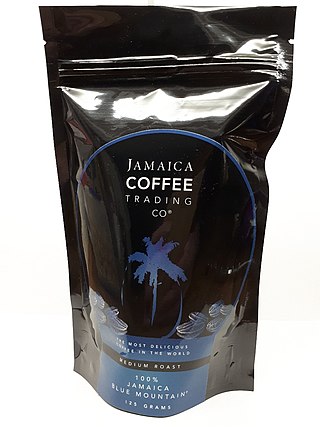Related Research Articles

The economy of the Dominican Republic is the seventh largest in Latin America, and is the largest in the Caribbean and Central American region. The Dominican Republic is an upper-middle income developing country with important sectors including mining, tourism, manufacturing, energy, real estate, infrastructure, telecommunications and agriculture. The Dominican Republic is on track to achieve its goal of becoming a high-income country by 2030, and is expected to grow 79% in this decade. The country is the site of the single largest gold mine in Latin America, the Pueblo Viejo mine. Although the service sector is currently the leading employer of Dominicans, agriculture remains an important sector in terms of the domestic market and is in second place in terms of export earnings. Tourism accounts for more than $7.4 billion in annual earnings in 2019. Free-trade zone earnings and tourism are the fastest-growing export sectors. A leading growth engine in the Free-trade zone sector is the production of medical equipment for export having a value-added per employee of $20,000 USD, total revenue of $1.5 billion USD, and a growth rate of 7.7% in 2019. The medical instrument export sector represents one of the highest-value added sectors of the country's economy, a true growth engine for the country's emerging market. Remittances are an important sector of the economy, contributing $8.2 billion in 2020. Most of these funds are used to cover household expenses, such as housing, food, clothing, health care and education. Secondarily, remittances have financed businesses and productive activities. Thirdly, this combined effect has induced investment by the private sector and helps fund the public sector through its value-added tax. The combined import market including the free-trade-zones amounts to a market of $20 billion a year in 2019. The combined export sector had revenues totaling $11 billion in 2019. The consumer market is equivalent to $61 billion in 2019. An important indicator is the average commercial loan interest rate, which directs short-term investment and stimulates long-term investment in the economy. It is currently 8.30%, as of June 2021.

Transport in the Dominican Republic utilizes a system of roads, airports, ports, harbours, and an urban railway.

San Cristóbal is a province in the southern region of Dominican Republic, located west of the capital Santo Domingo. With approximately 642,000 inhabitants, it is the fourth most populated province in the country, only behind Santo Domingo, Santiago and the National District. It borders the provinces Monseñor Nouel (north), Monte Plata (northeast), Santo Domingo (east), Peravia (west) and San José de Ocoa (northwest). The Caribbean Sea borders the province to the south. The provincial capital is the city of San Cristóbal.

Monte Plata is an eastern province of the Dominican Republic, and also the name of its capital city. It was split from San Cristóbal in 1992.

Puerto Plata ; is a province in northern Dominican Republic. It is divided into 9 municipalities, 12 municipal districts and its capital is the resort city of the same name. Neighboring provinces clockwise: Monte Cristi to the southwest, Valverde and Santiago to the south and Espailat to the east, along with the Septentrional mountain range to the north, and has a coastline with the Atlantic Ocean. The area has become an increasingly popular tourist attraction since the late 1990s mainly due to its fine beaches.

Santiago is a province which currently comprises one of the 32 provinces of the Dominican Republic. It is divided into 10 municipalities and its capital city is Santiago de los Caballeros. Located in north-central Dominican Republic, in the Cibao region, it is bordered by the provinces of Valverde to the north-west, Puerto Plata to the north, Espaillat and La Vega to the east, San Juan to the south and Santiago Rodríguez to the west.

The Cibao, usually referred as "El Cibao", is a region of the Dominican Republic located at the northern part of the country. As of 2009 the Cibao has a population of 5,622,378 making it the most populous region in the country.

Puerto Plata, officially known as San Felipe de Puerto Plata; is a major coastal city in the Dominican Republic, and capital of the province of Puerto Plata. The city is a major trading port. Puerto Plata has resorts such as Playa Dorada and Costa Dorada, which are located east of the city proper. There are 100,000 hotel beds in the city. The first aerial tramway of the Caribbean is located in Puerto Plata, in which visitors can ride up to the Pico Isabel de Torres, a 793-meter (2600-foot) high mountain within the city.

The Dominican Restoration War or the Dominican War of Restoration was a guerrilla war between 1863 and 1865 in the Dominican Republic between nationalists and Spain, the latter of which had recolonized the country 17 years after its independence. The war resulted in the restoration of Dominican sovereignty, the withdrawal of Spanish forces, the separation of the Captaincy General of Santo Domingo from Spain, and the establishment of a second republic in the Dominican Republic.

In the history of the Dominican Republic, the period of Era de Francia occurred in 1795 when France acquired the Captaincy General of Santo Domingo, annexed it into Saint-Domingue and briefly came to acquire the whole island of Hispaniola by the way of the Treaty of Basel, allowing Spain to cede the eastern province as a consequence of the French Revolutionary Wars.

The role of agriculture in the Bolivian economy in the late 1980s expanded as the collapse of the tin industry forced the country to diversify its productive and export base. Agricultural production as a share of GDP was approximately 23 percent in 1987, compared with 30 percent in 1960 and a low of just under 17 percent in 1979. The recession of the 1980s, along with unfavorable weather conditions, particularly droughts and floods, hampered output. Agriculture employed about 46 percent of the country's labor force in 1987. Most production, with the exception of coca, focused on the domestic market and self-sufficiency in food. Agricultural exports accounted for only about 15 percent of total exports in the late 1980s, depending on weather conditions and commodity prices for agricultural goods, hydrocarbons, and minerals.

Moca is the capital of Espaillat province in the Cibao region of the Dominican Republic, and is the tenth-largest city of the country with a population of 173,442 inhabitants. Moca is located 11 miles/18 kilometers east from the country’s second-largest city, Santiago. It is divided into eight municipal districts: San Víctor, Las Lagunas, José Contreras, Juan López, El Higuerito, La Ortega, Monte de la Jagua and Canca La Reina.

Agriculture in Panama is an important sector of the Panamanian economy. Major agricultural products include bananas, cocoa beans, coffee, coconuts, timber, beef, chicken, shrimp, corn, potatoes, rice, soybeans, and sugar cane.

Coffee production in Nicaragua has been an important part of its history and economy. It is one of the country's principal products. The areas most suitable for the cultivation of coffee have been Managua Department, Diriamba, San Marcos, Jinotepe, as well as the vicinity of Granada Department, Lake Nicaragua, Chontales Department, and in Nueva Segovia; historically, the best coffee is produced in Matagalpa and in Jinotega. Most of the coffee was grown in Managua Department, but Matagalpa Department produced the best bean quality. The most convenient altitude to grow coffee is 800 meters above the sea level.

Coffee production in Bolivia has had a long history in the country. Coffee is grown in regions of 800–2,300 metres (2,600–7,500 ft) above the sea level.

Tourism in the Dominican Republic is an important sector of the country's economy. More than 10 million tourists visited the Dominican Republic in 2023, making it the most popular tourist destination in the Caribbean and putting it in the top 5 overall in the Americas. The industry accounts for 11.6% of the nation's GDP and is a particularly important source of revenue in coastal areas of the country. The nation's tropical climate, white sand beaches, diverse mountainous landscape and colonial history attracts visitors from around the world. In 2022, the nation's tourism was named the best-performing nation post-pandemic with over 5% visitors more in comparison to pre-pandemic levels in 2019.

Coffee production in Jamaica began after 1728, when governor Sir Nicholas Lawes introduced the crop near Castleton, north of Kingston. Jamaican Blue Mountain Coffee is the special variety of coffee that is grown in the Blue Mountains region, which has the most conducive climate and topographical features; this variety is known for its scent and sweet taste. Most of Jamaica's coffee production is grown for export.

Coffee production in Martinique dates to 1723 and its establishment is credited to the French naval officer Gabriel de Clieu. It later spread to other places in the Caribbean and South America from Martinique, an overseas region of France.

Coffee production in Guadeloupe, an overseas region of France in the Caribbean Sea, has had commercial importance at various times in its history. The island's coffee heritage is being promoted through ecotourism.
Benguet coffee, also known as Benguet arabica, is a single-origin coffee varietal grown in the Cordillera highlands of the northern Philippines since the 19th century. It belongs to the species Coffea arabica, of the Typica variety. It is one of the main crops of farmers in the province of Benguet, which has a climate highly suitable for arabica cultivation. Benguet coffee is listed in the Ark of Taste international catalogue of endangered heritage foods by the Slow Food movement.
References
 This article incorporates text from this source, which is in the public domain : International Bureau of the American Republics's Santo Domingo (1892)
This article incorporates text from this source, which is in the public domain : International Bureau of the American Republics's Santo Domingo (1892) This article incorporates text from this source, which is in the public domain : Pan American Union's Coffee: Extensive Information and Statistics (1902)
This article incorporates text from this source, which is in the public domain : Pan American Union's Coffee: Extensive Information and Statistics (1902)
- 1 2 Pan American Union 1902, p. 41.
- ↑ Siegel & Alwang 2004, p. 32.
- 1 2 Siegel & Alwang 2004, pp. 30–31.
- ↑ Schoenrich 1918, p. 157.
- ↑ "Dominican Republic: Coffee, green, production quantity (tons)". Factfish.com. Retrieved 3 June 2015.
Bibliography
- Pan American Union (1902). Coffee: Extensive Information and Statistics (Public domain ed.). U.S. Government Printing Office.
- Schoenrich, Otto (1918). Santo Domingo: A Country with a Future (Public domain ed.). Macmillan. p. 157.
- Siegel, Paul; Alwang, Jeffrey R. (2004). Export Commodity Production and Broad-based Rural Development: Coffee and Cocoa in the Dominican Republic. World Bank Publications.